翻译术语解析
语言学 术语翻译及术语解释

术语翻译及术语解释汇总术语翻译1.Design features of language(语言的甄别特征)Arbitrariness(任意性),Duality(二层性/二重性),Creativity(创造性/原创性),Displacement(移位性),Cultural transmission(文化传播),Interchangeability(可互换性)2. Functions of languagereferential 指称功能poetic 诗学功能emotive情感功能conative 劝慰功能phatic寒暄功能metalingual function 元语言功能ideational function概念功能interpersonal function人际功能textual function语篇/文本功能Informative(信息/告知功能),Performative Function(施为功能),Emotive Function(情感功能),Phatic communion(寒暄交谈),Recreational Function(娱乐功能),3. Phonetics(语音学),Phonology(音系/音位学); Morphology(形态学),Syntax(句法学);Semantics(语义学),Pragmatics(语用学)Articulatory phonetics发音语音学Acoustic phonetics声学语音学Auditory phonetics听觉语音学Psycholinguistics心理语言学Sociolinguistics社会语言学Anthropological linguistics人类语言学Computational linguistics计算语言学Applied linguistics应用语言学Neurolinguistics神经语言学4. Descriptive vs. prescriptive描写式和规定式Synchronic vs. diachronic共时和历时Langue vs. parole语言和言语Competence vs. performance语言能力和语言行为5. V ocal tract 声道(resonating cavities共鸣腔),pharynx咽腔, oral cavity口腔and nasal cavity鼻腔.其它的一些发音器官:lungs肺, windpipe(trachea)气管, vocal folds声带, larynx喉, epiglottis会厌,次声门, pharynx咽, uvula小舌, hard palate硬腭,soft palate软腭, alveolar ridge齿龈6.Consonants and vowels(辅音和元音)A. Manners of articulation发音方式B. Places of articulation发音位置7. Stop (or plosive)爆破音Fricative摩擦音Approximant近似音Lateral (approximant)边音Affricates塞擦音, trill颤音and tap 闪音Bilabial双唇音Labiodental唇齿音Dental齿音Alveolar齿龈音Postal veolar后齿龈音Retroflex卷舌音Palatal硬腭音Velar软腭音Uvular小舌音, pharyngeal咽音glottal声门音monophthong vowel: 单元音diphthongs双元音triphthongs三元音Lax vowels短元音Tensed vowels长元音8.Coarticulation and phonetic transcription协同发音和标音anticipatory coarticulation先期协同发音perseverative coarticulation后滞协同发音. broad transcription宽式标音narrow transcription严式标音9. minimal pairs最小对立体Phoneme音位phonemic transcriptions音位转写phonetic transcriptions语音转写phones音子allophones音位变体complementary distribution互补分布phonetic similarity发音近似性Free variation自由变体assimilation同化regressive assimilation逆同化progressive assimilation顺同化phonological rule 音系规则Epenthesis增音binary 二分的Distinctive features区别特征Endocentric and Exocentric Constructions向心结构和离心结构subordinate and coordinate从属和并列Conceptual meaning概念意义Associative meaning:联想意义Connotative meaning内涵意义Social meaning社会意义Affective meaning情感意义Reflected meaning反射意义Collocative meaning搭配意义Thematic meaning主位意义denotation: 外延意义connotation: 内涵The referential theory:指称理论Semantic triangle语义三角Sense and reference:涵义和指称Synonymy同义关系Antonymy反义关系Hyponymy上下义关系Polysemy一词多义关系Homonymy 同音/形异意关系Dialectal synonyms 地域同义词Stylistic synonyms风格同义词Collocational synonyms搭配同义词gradable antonymy 等级反义关系cover term覆盖项Marked vs. unmarked terms标记项和非标记项complementary antonymy 互补反义关系converse antonymy 逆向反义关系homophones: 同音异义词homographs : 同形异义词complete homonyms semantic components语义部分术语解释1.Design feature的定义:the defining(最典型的,起决定作用的)properties ofhuman language that distinguish it from any animal system of communication. 2.Synchronic共时:It refers to the description of a language at some point of timein history.3.Diachronic历时:It studies the development or history of language. In otherwords, it refers to the description of a language as it changes through time .4.prescriptive规定式:A kind of linguistic s tudy aims to lay down rules for “correctand standard” behavior in using language.5.descriptive描写式: A kind of linguistic study aims to describe and analyze thelanguage people actually use.6.Arbitrariness(任意性):By saying that “language is arbitrary”, we mean thatthere is no logical connection between meaning and sound.7.Duality(二层性/二重性):it means that language is a system, which consists oftwo levels of structures, at the lower level there is the structure of sounds; at the higher level there is the structure of meaning.8.Displacement(移位性): it means that language can be used to communicateabout things that are not present in our immediate communicational context.petence语言能力:it refers to an ideal speaker’s knowledge of the underlyingsystem of rules in a language.10.Performance语言行为: it refers to the actual use of the language by a speaker ina real communicational context.ngue语言: it refers to the speaker’s understanding and knowledge of thelanguage that he speaks.12.Parole言语: it is the actual speaking of language by an individual speaker.13.Cultural transmission(文化传播):It refers to the fact that the details of thelinguistic system must be learned anew(重新,再)by each speaker. Language is not transmitted biologically from generation to generation.14.Phatic communion(寒暄交谈):it refers to ritual exchanges, exchanges that havelittle meaning but help to maintain our relationships with other people.15.Phonetics(语音学): it is the study of the characteristics of speech sounds andprovides methods for their description, classification and transcription.16.V owels元音:the sounds in the production of which no articulators come veryclose together and the air-stream passes through the vocal tract without obstruction.17.Consonants辅音:The sounds in the production of which there is an obstructionof the air-stream at some point of the vocal tract.18.Phonology: it is the study of the sound systems of languages and it is concernedwith the linguistic patterning of sounds in human languages. And it studies the way in which speakers of a language systematically use a selection of these sounds in order to express meaning.19.Phoneme音位: the smallest unit of sound in a language which can distinguish twowords.20.Allophone音位变体: it refers to the different forms of a phoneme.21.Assimilation: it is a process by which one sound takes on some or all thecharacteristics of a neighboring sound.22.Coarticulation: a kind of phonetic process in which simultaneous or overlappingarticulations are involved.plementary distribution互补分布:when two sounds never occur in thesame environment, they are in complementary distribution.24.Free variation自由变体: if two sounds occurring in the same environment do notcontrast, that is, the substitution of one for the other does not produce a different word form, but merely a different pronunciation of the same word, then the two sounds are in free variation.25.Distinctive features区别特征:A phonetic feature which distinguishes onephonological unit, especially one phoneme, from another.26.minimal pairs最小对立体----- which can be defined as pairs of words whichdiffer from each other by only one sound.27.vowel glides滑音: The vowels involving movement from one sound to anotherare called vowel glides.28.Epenthesis增音:it means a process of inserting a sound after another sound.29.Substitution relation: it refers to the relation specifically between an individualunit and others that can replace it in a given sequence.30.Endocentric construction is one whose distribution is functionally equivalent, orapproaching equivalence, to one of its constituents, which serves as the centre, or head, of the whole.31.Exocentric construction: a group of syntactically related words where none ofthem is functionally equivalent to the group as a whole, that is, there is no definable center or head inside the group32.Reference: it is the relationship between words and the objects, actions orproperties that the words stand for. It deals with the extra-linguistic relationships between words and expressions and the world they describe.(具体的物质性的东西)33.Synonymy :It refers to the sameness sense relations between words.ponential analysis :Componential analysis defines the meaning of alexical element in terms of semantic components语义部分.35.Sense: it refers to the complex system of relationships that hold between linguisticelements themselves, it is concerned only with intra-linguistic relations.(概念性的东西)36.Semantics:semantics is the study of the meaning of linguistic units, words andsentences in particular.37.Homonymy: the phenomenon that words having different meanings have the sameform, i.e., different words are identical in sound or spelling, or in both.38.Antonymy:It refers to the oppositeness sense relations between words.39.Hyponymy上下义关系:Hyponymy indicates sense inclusiveness. The upperterm in this sense relation is called superordinate上义词,and the lower terms, hyponyms下义词, members of the same class are called co-hyponyms.。
英语翻译家基础:专业术语翻译
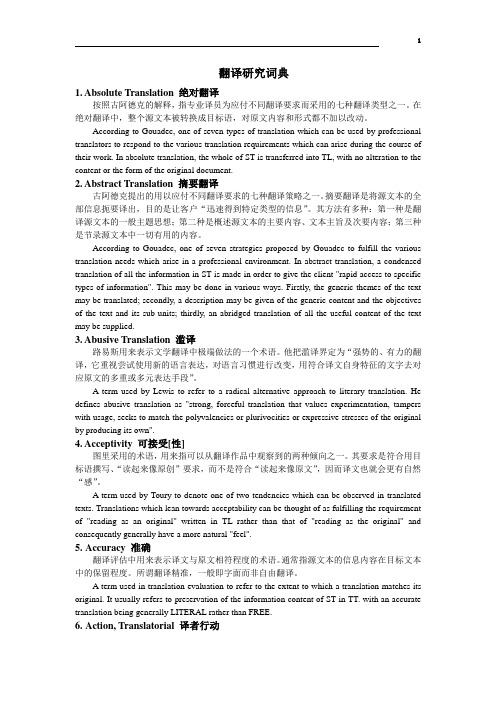
翻译研究词典1. Absolute Translation 绝对翻译按照古阿德克的解释,指专业译员为应付不同翻译要求而采用的七种翻译类型之一。
在绝对翻译中,整个源文本被转换成目标语,对原文内容和形式都不加以改动。
According to Gouadec, one of seven types of translation which can be used by professional translators to respond to the various translation requirements which can arise during the course of their work. In absolute translation, the whole of ST is transferred into TL, with no alteration to the content or the form of the original document.2. Abstract Translation 摘要翻译古阿德克提出的用以应付不同翻译要求的七种翻译策略之一。
摘要翻译是将源文本的全部信息扼要译出,目的是让客户“迅速得到特定类型的信息”。
其方法有多种:第一种是翻译源文本的一般主题思想;第二种是概述源文本的主要内容、文本主旨及次要内容;第三种是节录源文本中一切有用的内容。
According to Gouadec, one of seven strategies proposed by Gouadec to fulfill the various translation needs which arise in a professional environment. In abstract translation, a condensed translation of all the information in ST is made in order to give the client "rapid access to specific types of information". This may be done in various ways. Firstly, the generic themes of the text may be translated; secondly, a description may be given of the generic content and the objectives of the text and its sub-units; thirdly, an abridged translation of all the useful content of the text may be supplied.3. Abusive Translation 滥译路易斯用来表示文学翻译中极端做法的一个术语。
英语翻译家基础:专业术语翻译

翻译研究词典1. Absolute Translation 绝对翻译按照古阿德克的解释,指专业译员为应付不同翻译要求而采用的七种翻译类型之一。
在绝对翻译中,整个源文本被转换成目标语,对原文内容和形式都不加以改动。
According to Gouadec, one of seven types of translation which can be used by professional translators to respond to the various translation requirements which can arise during the course of their work. In absolute translation, the whole of ST is transferred into TL, with no alteration to the content or the form of the original document.2. Abstract Translation 摘要翻译古阿德克提出的用以应付不同翻译要求的七种翻译策略之一。
摘要翻译是将源文本的全部信息扼要译出,目的是让客户“迅速得到特定类型的信息”。
其方法有多种:第一种是翻译源文本的一般主题思想;第二种是概述源文本的主要内容、文本主旨及次要内容;第三种是节录源文本中一切有用的内容。
According to Gouadec, one of seven strategies proposed by Gouadec to fulfill the various translation needs which arise in a professional environment. In abstract translation, a condensed translation of all the information in ST is made in order to give the client "rapid access to specific types of information". This may be done in various ways. Firstly, the generic themes of the text may be translated; secondly, a description may be given of the generic content and the objectives of the text and its sub-units; thirdly, an abridged translation of all the useful content of the text may be supplied.3. Abusive Translation 滥译路易斯用来表示文学翻译中极端做法的一个术语。
术语全译策略--直译意译
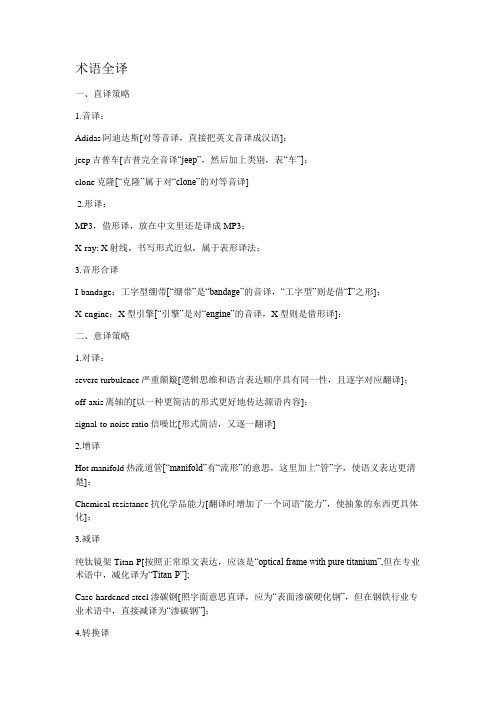
术语全译一、直译策略1.音译:Adidas阿迪达斯[对等音译,直接把英文音译成汉语];jeep吉普车[吉普完全音译“jeep”,然后加上类别,表“车”];clone克隆[“克隆”属于对“clone”的对等音译]2.形译:MP3,借形译,放在中文里还是译成MP3;X-ray: X射线,书写形式近似,属于表形译法;3.音形合译I-bandage:工字型绷带[“绷带”是“bandage”的音译,“工字型”则是借“I”之形];X-engine:X型引擎[“引擎”是对“engine”的音译,X型则是借形译];二、意译策略1.对译:severe turbulence严重颠簸[逻辑思维和语言表达顺序具有同一性,且逐字对应翻译];off-axis离轴的[以一种更简洁的形式更好地传达源语内容];signal-to-noise ratio信噪比[形式简洁,又逐一翻译]2.增译Hot manifold热流道管[“manifold”有“流形”的意思,这里加上“管”字,使语义表达更清楚];Chemical resistance抗化学品能力[翻译时增加了一个词语“能力”,使抽象的东西更具体化];3.减译纯钛镜架Titan-P[按照正常原文表达,应该是“optical frame with pure titanium”,但在专业术语中,减化译为“Titan-P”];Case-hardened steel渗碳钢[照字面意思直译,应为“表面渗碳硬化钢”,但在钢铁行业专业术语中,直接减译为“渗碳钢”];4.转换译Contact probe触针[“contact”含义是“接触”,相当于一个动词,但这里译为名词,指手表里的“触针”];Nose bridge鼻中[“bridge”是“桥梁”的作用,但这里翻译成“中间的”意思,将名词转换为形容词使用,更贴近眼镜的特点];Loss on property retired财产退废损失[语序调整、词性转换使原有表达更加有逻辑];5.分译和合译Stainless & heat resisting steel不锈耐热钢[按照一般译法,应该以为“不锈钢和耐热钢”,但在钢铁行业,直接合译为“不锈耐热钢”];三、直译兼意译策略1.音意兼译:miniskirt迷你裙[“迷你”是“mini”的音译,“裙”是“skirt”的意译];internet因特网[“因特”是“inter”的音译,“net”的中文意义为“网”];2.形译兼意译J-particle:J粒子[借“J”的形,“particle”译为“粒子”];PH-value:PH值[借PH之形,“value”译为“值”];3.音、形、意兼译Fertility vitamin-E:维他命E[音译兼译,再加形译]。
翻译术语(理论笔译)
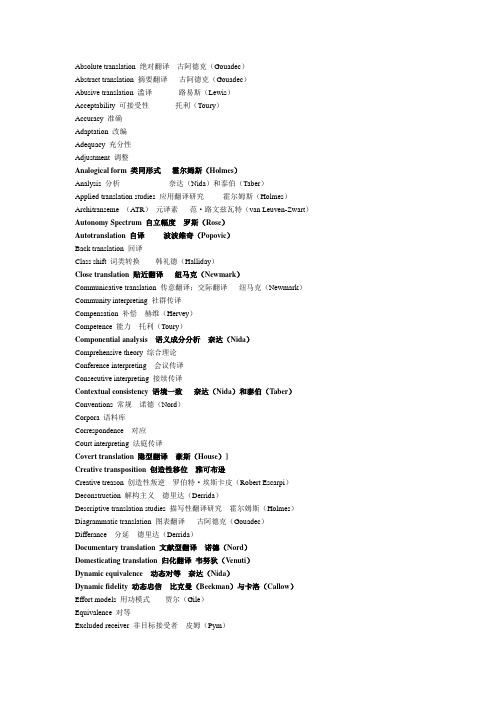
Absolute translation 绝对翻译古阿德克(Gouadec)Abstract translation 摘要翻译古阿德克(Gouadec)Abusive translation 滥译路易斯(Lewis)Acceptability 可接受性托利(Toury)Accuracy 准确Adaptation 改编Adequacy 充分性Adjustment 调整Analogical form 类同形式霍尔姆斯(Holmes)Analysis 分析奈达(Nida)和泰伯(Taber)Applied translation studies 应用翻译研究霍尔姆斯(Holmes)Architranseme (ATR)元译素范·路文兹瓦特(van Leuven-Zwart)Autonomy Spectrum 自立幅度罗斯(Rose)Autotranslation 自译波波维奇(Popovic)Back translation 回译Class shift 词类转换韩礼德(Halliday)Close translation 贴近翻译纽马克(Newmark)Communicative translation 传意翻译;交际翻译纽马克(Newmark)Community interpreting 社群传译Compensation 补偿赫维(Hervey)Competence 能力托利(Toury)Componential analysis 语义成分分析奈达(Nida)Comprehensive theory 综合理论Conference interpreting 会议传译Consecutive interpreting 接续传译Contextual consistency 语境一致奈达(Nida)和泰伯(Taber)Conventions 常规诺德(Nord)Corpora 语料库Correspondence 对应Court interpreting 法庭传译Covert translation 隐型翻译豪斯(House)]Creative transposition 创造性移位雅可布逊Creative treason 创造性叛逆罗伯特·埃斯卡皮(Robert Escarpi)Deconstruction 解构主义德里达(Derrida)Descriptive translation studies 描写性翻译研究霍尔姆斯(Holmes)Diagrammatic translation 图表翻译古阿德克(Gouadec)Differance 分延德里达(Derrida)Documentary translation 文献型翻译诺德(Nord)Domesticating translation 归化翻译韦努狄(Venuti)Dynamic equivalence 动态对等奈达(Nida)Dynamic fidelity 动态忠信比克曼(Beekman)与卡洛(Callow)Effort models 用功模式贾尔(Gile)Equivalence 对等Excluded receiver 非目标接受者皮姆(Pym)Exegetic translation 诠释性翻译赫维(Hervey)和希金斯(Higgins)Exoticism 异国情调赫维(Hervey)和希金斯(Higgins)Expectancy norms 期待规范切斯特曼(Chesterman)Explicitation 明示维纳(Vinay)和达尔贝勒纳(Darbelnet)Expressive text 表情型文本赖斯(Reiss)Extraneous form 外来形式霍尔姆斯(Holmes)Faithfulness 忠实Foreignizing translation 异化翻译韦努狄(Venuti)Formal corresponding 形式对应卡特福德(Catford)Formal equivalence 形式对等奈达(Nida)Free translation [sense-for-sense translation 意对意翻译] {literal translation 字面翻译;word-for-word translation词对词翻译} 自由译Full translation 全文翻译General theories of translation 普通翻译理论霍尔姆斯(Holmes)Gist translation 要旨翻译赫维(Hervey)和希金斯(Higgins)Gloss translation 释词翻译奈达(Nida)Grammatical transposition 语法置换赫维(Hervey)和希金斯(Higgins)Hermeneutic motion 诠释步骤斯坦纳(Steiner)Hierarchy of Correspondences 对应层级霍尔姆斯(Holmes)Horizontal translation 横向翻译福勒纳(Folena)Hyperinformation 超额信息赖斯(Reiss)和弗米尔(Vermeer)Idiomatic translation 地道翻译比克曼(Beekman)与卡洛(Callow)Imitation 拟译 1.德莱顿(Dryden)2.利弗威尔(Lefevere)Indeterminacy 不确定性Information offer 信息提供弗米尔(Vermeer)Informative texts 信息文本赖斯(Reiss)Initial norms 初始规范托利(Toury)Instrumental translation 工具翻译诺德(Nord)Integral translation 整合翻译范·路文兹瓦特(van Leuven-Zwart)Interlineal translation 隔行翻译{free translation} 赫维(Hervey)和希金斯(Higgins)Interlinear translation 逐行翻译Interlingual translation 语际翻译雅可布逊(Jacobson)Intersemiotic translation 符际翻译雅可布逊(Jacobson)Intralingual translation 语内翻译雅可布逊(Jacobson)Intra-system shift 系统内转换卡特福德(Catford)Inverse translation 逆向翻译Kernel sentence 核心句Keyword translation 关键词翻译古阿德克(Gouadec)Level shift 层次转换卡特福德(Catford)Lexical translation 词汇翻译卡特福德(Catford)Liaison interpreting[Bilateral interpreting 双边传译] 联络传译凯斯(Keith)Linguistic translation 语言翻译Literal translation 字面翻译;直译Mapping 图谱霍尔姆斯(Holmes)Matricial norms 矩阵规范托利(Toury)Meta-language 元语言霍尔姆斯(Holmes)Metatext 元文本Mimetic form 模仿形式霍尔姆斯(Holmes)Mutation 变异范·路文兹瓦特(van Leuven-Zwart)Naturalness 自然性Negative shift 负面转换Norms 规范Obligatory equivalents 必要对等语奈达(Nida)Oblique translation 曲径翻译维纳(Vinay)和达尔贝勒纳(Darbelnet)Operational model 操作模式巴斯盖特(Bathgate)Operational norms 操作规范托利(Toury)Optional equivalents 可换对等语奈达(Nida)Overlapping translation 重合翻译赫维(Hervey)和希金斯(Higgins)Overt translation 显型翻译豪斯(House)Overtranslation 超额翻译维纳(Vinay)和达尔贝勒纳(Darbelnet)Paradigmatic equivalence 范式对等波波维奇(Popovic)Paraphrase 释译德莱顿(Dryden)Partial theories of translation 局部翻译理论霍尔姆斯(Holmes)Participative receiver 参与型接受者皮姆(Pym)Particularizing translation 具体化翻译赫维(Hervey)和希金斯(Higgins)Performance 运用托利(Toury)Phonemic translation 音素翻译利弗威尔(Lefevere)Phonological translation 音位翻译卡特福德(Catford)Pivot language 中枢语言Polysystem theory 多元文化理论埃文·佐哈尔(Even-Zohar)Pragmatic translation[pragmatic approach语用途径] 语用翻译Preliminary norms 预先规范托利(Toury)Prescriptive translation studies 规定翻译研究托利(Toury)Primary translation 首级翻译迪勒(Diller)和康纳留斯(Kornelius)Problem-restricted theories of translation 关于问题的翻译理论霍尔姆斯(Holmes)Process-oriented translation theories 过程取向翻译研究霍尔姆斯(Holmes)Product-oriented translation studies 成品取向翻译研究霍尔姆斯(Holmes)Professional norms 翻译规范切斯特曼(Chesterman)Prospective translation 前瞻式翻译波斯特盖特(Postgate)Prototext 原型文本波波维奇(Popovic)Pseudotranslation 伪翻译Pure language[Logos 逻各斯] 纯语言沃尔特·本雅明(Walter Benjamin)Radical translation 原始翻译奎因(Quine)Rank-bound translation 级阶受限翻译卡特福德(Catford)Realia 独有特征弗拉科夫(Vlakhov)和弗罗林(Florin)Receptor language 接受语奈达(Nida)和泰伯(Taber)Translation with reconstruction 重构式翻译古阿德克(Gouadec)Redundancy 冗余奈达(Nida)Refraction 折射利弗威尔(Lefevere)Regulative translational conventions 规约性翻译常规诺德(Nord)Relay interpreting 转接传译Repertoreme 知识库要素托利(Toury)Resistancy 阻抗韦努狄(Venuti)Restricted translation 受限翻译卡特福德(Catford)Restructuring 重组奈达(Nida)和泰伯(Taber)Retrospective translation 后瞻式翻译波斯特盖特(Postgate)Rewriting 重写利弗威尔(Lefevere)Rhymed translation 韵体翻译利弗威尔(Lefevere)Secondary translation 二级翻译迪勒(Diller)和康纳留斯(Kornelius)Selective translation 选译古阿德克(Gouadec)Semantic disambiguation 语义消歧Semantic translation 语义翻译纽马克(Newmark)Serial translation 序列翻译卡塞格兰德(Casagrande)Service translation [Inverse translation 逆向翻译] 服务型翻译纽马克(Newmark)Sight translation 视译Signed language translation 手语传译Simultaneous interpreting 同声传译Skopos theory 目的论赖斯(Reiss)和弗米尔(Vermeer)Source language 源语Source text 源文本Source text-oriented translation studies 源文本取向翻译研究Specification 具体化Structure shift 结构转换卡特福德(Catford)Stylistic equivalence 文体对等Target language 目标语Term banks 术语库Terminology 术语Text typology 文本类型学Textual equivalence 文本对等卡特福德(Catford)Textual norms 文本规范托利(Toury)Thick translation 增量翻译阿皮尔(Appiah)Think-aloud translation 有声思维记录Third code 第三语码弗劳利(Frawley)Time-restricted theories of translation 关于时域的翻译理论霍尔姆斯(Holmes)Total translation 完全翻译卡特福德(Catford)Transcription 注音Transeme 译素范·路文兹瓦特(van Leuven-Zwart)Transfer 转移Transference 迁移卡特福德(Catford)Translatability 可译性Translationese [Third language 第三语言] 翻译体Translatorial action 译者行动赫尔兹·曼塔里(Holz Mänttäri)Transliteration 音译Transposition 置换维纳(Vinay)和达尔贝勒纳(Darbelnet)Unbounded translation 不受限翻译卡特福德(Catford)Undertranslation 欠额翻译纽马克(Newmark)Unit of translation 翻译单位Universals of translation 翻译普遍特征Verbal consistency 词语一致Verifiability 可核实性赖斯(Reiss)和弗米尔(Vermeer)Vertical translation 纵向翻译福勒纳Voids 空缺Whispered interpreting 耳语传译Writer-oriented machine translation 作者取向机器翻译。
翻译概论术语整理
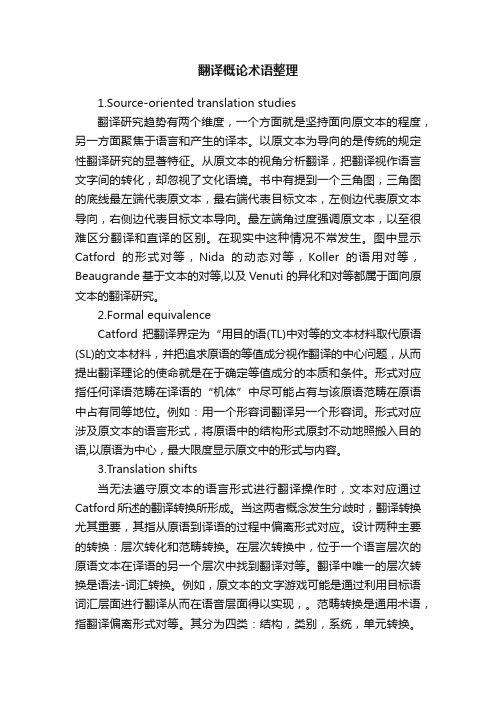
翻译概论术语整理1.Source-oriented translation studies翻译研究趋势有两个维度,一个方面就是坚持面向原文本的程度,另一方面聚焦于语言和产生的译本。
以原文本为导向的是传统的规定性翻译研究的显著特征。
从原文本的视角分析翻译,把翻译视作语言文字间的转化,却忽视了文化语境。
书中有提到一个三角图,三角图的底线最左端代表原文本,最右端代表目标文本,左侧边代表原文本导向,右侧边代表目标文本导向。
最左端角过度强调原文本,以至很难区分翻译和直译的区别。
在现实中这种情况不常发生。
图中显示Catford的形式对等,Nida的动态对等,Koller的语用对等,Beaugrande 基于文本的对等,以及Venuti的异化和对等都属于面向原文本的翻译研究。
2.Formal equivalenceCatford把翻译界定为“用目的语(TL)中对等的文本材料取代原语(SL)的文本材料,并把追求原语的等值成分视作翻译的中心问题,从而提出翻译理论的使命就是在于确定等值成分的本质和条件。
形式对应指任何译语范畴在译语的“机体”中尽可能占有与该原语范畴在原语中占有同等地位。
例如:用一个形容词翻译另一个形容词。
形式对应涉及原文本的语言形式,将原语中的结构形式原封不动地照搬入目的语,以原语为中心,最大限度显示原文中的形式与内容。
3.Translation shifts当无法遵守原文本的语言形式进行翻译操作时,文本对应通过Catford所述的翻译转换所形成。
当这两者概念发生分歧时,翻译转换尤其重要,其指从原语到译语的过程中偏离形式对应。
设计两种主要的转换:层次转化和范畴转换。
在层次转换中,位于一个语言层次的原语文本在译语的另一个层次中找到翻译对等。
翻译中唯一的层次转换是语法-词汇转换。
例如,原文本的文字游戏可能是通过利用目标语词汇层面进行翻译从而在语音层面得以实现,。
范畴转换是通用术语,指翻译偏离形式对等。
其分为四类:结构,类别,系统,单元转换。
翻译术语的名词解释
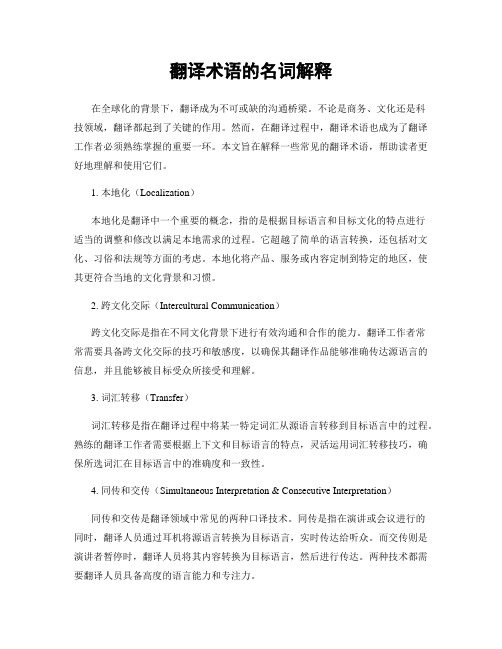
翻译术语的名词解释在全球化的背景下,翻译成为不可或缺的沟通桥梁。
不论是商务、文化还是科技领域,翻译都起到了关键的作用。
然而,在翻译过程中,翻译术语也成为了翻译工作者必须熟练掌握的重要一环。
本文旨在解释一些常见的翻译术语,帮助读者更好地理解和使用它们。
1. 本地化(Localization)本地化是翻译中一个重要的概念,指的是根据目标语言和目标文化的特点进行适当的调整和修改以满足本地需求的过程。
它超越了简单的语言转换,还包括对文化、习俗和法规等方面的考虑。
本地化将产品、服务或内容定制到特定的地区,使其更符合当地的文化背景和习惯。
2. 跨文化交际(Intercultural Communication)跨文化交际是指在不同文化背景下进行有效沟通和合作的能力。
翻译工作者常常需要具备跨文化交际的技巧和敏感度,以确保其翻译作品能够准确传达源语言的信息,并且能够被目标受众所接受和理解。
3. 词汇转移(Transfer)词汇转移是指在翻译过程中将某一特定词汇从源语言转移到目标语言中的过程。
熟练的翻译工作者需要根据上下文和目标语言的特点,灵活运用词汇转移技巧,确保所选词汇在目标语言中的准确度和一致性。
4. 同传和交传(Simultaneous Interpretation & Consecutive Interpretation)同传和交传是翻译领域中常见的两种口译技术。
同传是指在演讲或会议进行的同时,翻译人员通过耳机将源语言转换为目标语言,实时传达给听众。
而交传则是演讲者暂停时,翻译人员将其内容转换为目标语言,然后进行传达。
两种技术都需要翻译人员具备高度的语言能力和专注力。
5. 策略(Translation Strategy)翻译策略是指翻译工作者在面对不同的翻译问题时所采取的方法和决策。
由于每个翻译问题都具有其独特的特点,翻译策略的选择对于最终翻译作品的质量至关重要。
常见的翻译策略包括直译、意译、补充信息等。
学翻译必备的20个专业术语

学翻译必备的20个专业术语空中传译 2019-09-19 17:57:451. 归化:归化(法)是1995年由美国翻译理论家劳伦斯·韦努蒂在《译者的隐形》⼀书中提出的,是对意译概念的延伸,突破了语⾔因素的局限,扩展到语⾔、⽂化和美学等因素。
/归化法就是采取民族中⼼主义的态度,使外语⽂本符合译⼊语的⽂化价值观,把原作者带⼊译⼊语⽂化。
严复、林纾等都是“归化派”的代表,以其但后来由于“归化理论”的统治,某种意义上来说,导致了“⽂化帝国主义”的倾向。
/我们应该以异化为主,归化为辅,充分反应原作的⽂化特征,传递原语⽂化。
2. 异化:异化(法)是1995年由美国翻译理论家劳伦斯·韦努蒂在《译者的隐形》⼀书中提出的,是对直译概念的延伸,突破了语⾔因素的局限,扩展到语⾔、⽂化和美学等因素。
异化法就是接受外语⽂本的语⾔和⽂化差异,把读者带⼊外国情景。
/鲁迅是“异化派”的代表,但由于译作过分拘泥于原作,未得到⼴泛认可。
长期以来,由于“归化理论”对原语⽂化的损害,改⾰开放后,异化法在翻译界开始越来越得到重视,此法有助于充分反映原语⽂化特征,充分表达原⽂意义。
/但是,异化亦⾮万能,运⽤异化法我们既不能超越语⾔⽂化的规范限度,也不能超越读者的接受限度。
3. 语际翻译指不同语⾔之间的翻译活动,如将汉语⽂本译为外语⽂本,或将外语⽂本译为汉语⽂本。
/在中国,始于东汉末年终于北宋末年⽽盛于唐代的佛经翻译活动,可以说对中国⽂化的每⼀个层⾯都产⽣过深刻的影响。
同样,明末清初的科技翻译对清末⼒求⾃强⾰新的知识分⼦起到了巨⼤的启蒙作⽤。
语际翻译活动还直接影响到了中国现代性的形成,近代的⼀些思想家都是以语际翻译为利器,改造社会、⽂学以及语⾔的。
/我认为,语际翻译体现的是⼀种跨⽂化意义传递,是不同语⾔背景的⼈类进⾏思想交流的桥梁。
4. 语内翻译指同⼀语⾔的各个语⾔变体之间的翻译,如将⽅⾔译成民族共同语,将古代语译成现代语,把将歌译成散⽂等。
翻译专业术语大全

翻译专业术语大全本文为翻译专业术语大全,介绍翻译领域中常见的术语及其解释。
一、翻译1. Translation 翻译:将一种语言的文本用另一种语言表达的过程。
2. Translator/Interpreter 翻译员:从一种语言转换为另一种语言的专业人士。
3. Source Language(SL)源语言:被翻译文本的语言。
4. Target Language(TL)目标语言:翻译后的目标语言。
5. Bilingual 双语的:能听说读写两种语言的人。
6. Multilingual 多种语言的:能听说读写多种语言的人。
7. Translate 翻译:将源语言文本转换成目标语言文本。
8. Interpretation 口译:将源语言口述转换成目标语言口述。
9. Localization 本地化:将一个产品从一种语言转换成另一种语言,并符合该地区的文化、政治、习俗等环境。
二、文本类型1. Technical Text 技术文本:对某种科技、专业领域的知识、技能、思想等进行描述的文本。
2. Legal Text 法律文本:含法律内容的文本,如合同、法规等。
3. Medical Text 医学文本:含医学内容的文本,如医学论文、病历等。
4. Financial Text 金融文本:含金融内容的文本,如财经新闻、报告等。
5. Literary Text 文学文本:小说、诗歌等文学作品。
6. Commercial Text 商业文本:广告、宣传资料等商业性文本。
三、翻译术语1. Translation Theory 翻译理论:研究翻译规律、方法和技巧的学科。
2. Translation Studies 翻译研究:研究翻译现象、理论和实践问题的学科。
3. Translation Criticism 翻译批评:通过对原著和译文进行分析、比较和评价来评判翻译质量的学科。
4. Translation Equivalence 翻译等值性:翻译过程中,源语言和目标语言表达方式和意义上的相当性。
翻译学词典术语
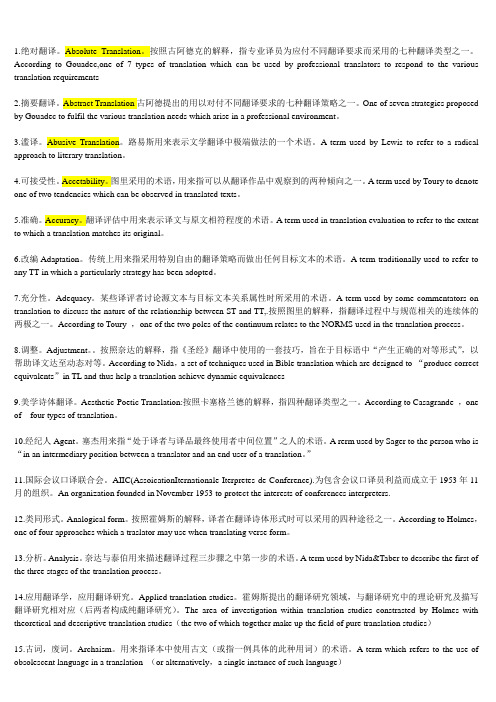
1.绝对翻译。
Absolute Translation。
按照古阿德克的解释,指专业译员为应付不同翻译要求而采用的七种翻译类型之一。
According to Gouadec,one of 7 types of translation which can be used by professional translators to respond to the various translation requirements2.摘要翻译。
Abstract Translation古阿德提出的用以对付不同翻译要求的七种翻译策略之一。
One of seven strategies proposed by Gouadec to fulfil the various translation needs which arise in a professional environment。
3.滥译。
Abusive Translation。
路易斯用来表示文学翻译中极端做法的一个术语。
A term used by Lewis to refer to a radical approach to literary translation。
4.可接受性。
Accetability。
图里采用的术语,用来指可以从翻译作品中观察到的两种倾向之一。
A term used by Toury to denote one of two tendencies which can be observed in translated texts。
5.准确。
Accuracy。
翻译评估中用来表示译文与原文相符程度的术语。
A term used in translation evaluation to refer to the extent to which a translation matches its original。
6.改编Adaptation。
[翻译研究词典]术语翻译
![[翻译研究词典]术语翻译](https://img.taocdn.com/s3/m/7dfbc83fbc64783e0912a21614791711cc79793e.png)
Gramma cal Transla on Gramma al Transposi on Graphological Transla on Hermeneu c Mo on Hierarchy of Correspondences
Historical Fidelity Homophonic Transla on Horizontal Transla on Hyperinforma on IA (Informa on Offer) Iden ty Idioma c Transla on Idioma city Imita on Indeterminacy Indirect Transla on
Community Interpre ng Dialogue Interpre ng Public Service Interpre ng Commuta on Comparable Corpora Compensa on Competence Componen al Analysis Computer-assisted Transla on Concordance Conference Interpre ng
经纪人 国际会议口译联合会 类同形式 分析 感染型文本 应用翻译研究;应用翻译学 古词;废词 元译素 关于范围的翻译理论 元译素 听觉媒介型文本
(完整word版)语言学 术语翻译及术语解释
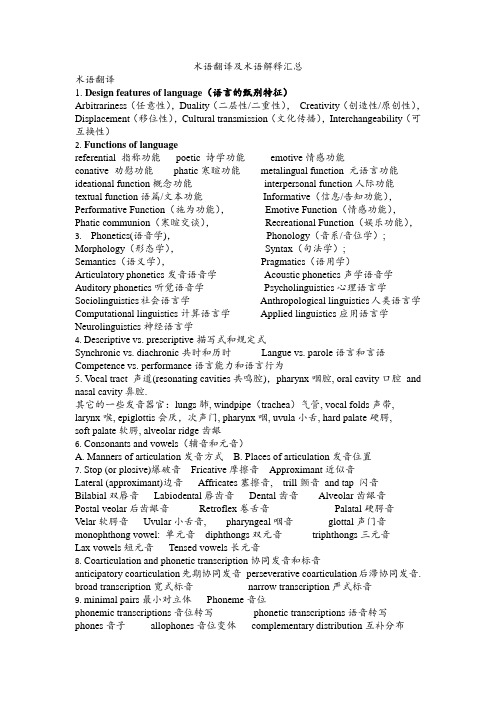
术语翻译及术语解释汇总术语翻译1.Design features of language(语言的甄别特征)Arbitrariness(任意性),Duality(二层性/二重性),Creativity(创造性/原创性),Displacement(移位性),Cultural transmission(文化传播),Interchangeability(可互换性)2. Functions of languagereferential 指称功能poetic 诗学功能emotive情感功能conative 劝慰功能phatic寒暄功能metalingual function 元语言功能ideational function概念功能interpersonal function人际功能textual function语篇/文本功能Informative(信息/告知功能),Performative Function(施为功能),Emotive Function(情感功能),Phatic communion(寒暄交谈),Recreational Function(娱乐功能),3. Phonetics(语音学),Phonology(音系/音位学); Morphology(形态学),Syntax(句法学);Semantics(语义学),Pragmatics(语用学)Articulatory phonetics发音语音学Acoustic phonetics声学语音学Auditory phonetics听觉语音学Psycholinguistics心理语言学Sociolinguistics社会语言学Anthropological linguistics人类语言学Computational linguistics计算语言学Applied linguistics应用语言学Neurolinguistics神经语言学4. Descriptive vs. prescriptive描写式和规定式Synchronic vs. diachronic共时和历时Langue vs. parole语言和言语Competence vs. performance语言能力和语言行为5. V ocal tract 声道(resonating cavities共鸣腔),pharynx咽腔, oral cavity口腔and nasal cavity鼻腔.其它的一些发音器官:lungs肺, windpipe(trachea)气管, vocal folds声带, larynx喉, epiglottis会厌,次声门, pharynx咽, uvula小舌, hard palate硬腭,soft palate软腭, alveolar ridge齿龈6.Consonants and vowels(辅音和元音)A. Manners of articulation发音方式B. Places of articulation发音位置7. Stop (or plosive)爆破音Fricative摩擦音Approximant近似音Lateral (approximant)边音Affricates塞擦音, trill颤音and tap 闪音Bilabial双唇音Labiodental唇齿音Dental齿音Alveolar齿龈音Postal veolar后齿龈音Retroflex卷舌音Palatal硬腭音Velar软腭音Uvular小舌音, pharyngeal咽音glottal声门音monophthong vowel: 单元音diphthongs双元音triphthongs三元音Lax vowels短元音Tensed vowels长元音8.Coarticulation and phonetic transcription协同发音和标音anticipatory coarticulation先期协同发音perseverative coarticulation后滞协同发音. broad transcription宽式标音narrow transcription严式标音9. minimal pairs最小对立体Phoneme音位phonemic transcriptions音位转写phonetic transcriptions语音转写phones音子allophones音位变体complementary distribution互补分布phonetic similarity发音近似性Free variation自由变体assimilation同化regressive assimilation逆同化progressive assimilation顺同化phonological rule 音系规则Epenthesis增音binary 二分的Distinctive features区别特征Endocentric and Exocentric Constructions向心结构和离心结构subordinate and coordinate从属和并列Conceptual meaning概念意义Associative meaning:联想意义Connotative meaning内涵意义Social meaning社会意义Affective meaning情感意义Reflected meaning反射意义Collocative meaning搭配意义Thematic meaning主位意义denotation: 外延意义connotation: 内涵The referential theory:指称理论Semantic triangle语义三角Sense and reference:涵义和指称Synonymy同义关系Antonymy反义关系Hyponymy上下义关系Polysemy一词多义关系Homonymy 同音/形异意关系Dialectal synonyms 地域同义词Stylistic synonyms风格同义词Collocational synonyms搭配同义词gradable antonymy 等级反义关系cover term覆盖项Marked vs. unmarked terms标记项和非标记项complementary antonymy 互补反义关系converse antonymy 逆向反义关系homophones: 同音异义词homographs : 同形异义词complete homonyms semantic components语义部分术语解释1.Design feature的定义:the defining(最典型的,起决定作用的)properties ofhuman language that distinguish it from any animal system of communication. 2.Synchronic共时:It refers to the description of a language at some point of timein history.3.Diachronic历时:It studies the development or history of language. In otherwords, it refers to the description of a language as it changes through time .4.prescriptive规定式:A kind of linguistic s tudy aims to lay down rules for “correctand standard” behavior in using language.5.descriptive描写式: A kind of linguistic study aims to describe and analyze thelanguage people actually use.6.Arbitrariness(任意性):By saying that “language is arbitrary”, we mean thatthere is no logical connection between meaning and sound.7.Duality(二层性/二重性):it means that language is a system, which consists oftwo levels of structures, at the lower level there is the structure of sounds; at the higher level there is the structure of meaning.8.Displacement(移位性): it means that language can be used to communicateabout things that are not present in our immediate communicational context.petence语言能力:it refers to an ideal speaker’s knowledge of the underlyingsystem of rules in a language.10.Performance语言行为: it refers to the actual use of the language by a speaker ina real communicational context.ngue语言: it refers to the speaker’s understanding and knowledge of thelanguage that he speaks.12.Parole言语: it is the actual speaking of language by an individual speaker.13.Cultural transmission(文化传播):It refers to the fact that the details of thelinguistic system must be learned anew(重新,再)by each speaker. Language is not transmitted biologically from generation to generation.14.Phatic communion(寒暄交谈):it refers to ritual exchanges, exchanges that havelittle meaning but help to maintain our relationships with other people.15.Phonetics(语音学): it is the study of the characteristics of speech sounds andprovides methods for their description, classification and transcription.16.V owels元音:the sounds in the production of which no articulators come veryclose together and the air-stream passes through the vocal tract without obstruction.17.Consonants辅音:The sounds in the production of which there is an obstructionof the air-stream at some point of the vocal tract.18.Phonology: it is the study of the sound systems of languages and it is concernedwith the linguistic patterning of sounds in human languages. And it studies the way in which speakers of a language systematically use a selection of these sounds in order to express meaning.19.Phoneme音位: the smallest unit of sound in a language which can distinguish twowords.20.Allophone音位变体: it refers to the different forms of a phoneme.21.Assimilation: it is a process by which one sound takes on some or all thecharacteristics of a neighboring sound.22.Coarticulation: a kind of phonetic process in which simultaneous or overlappingarticulations are involved.plementary distribution互补分布:when two sounds never occur in thesame environment, they are in complementary distribution.24.Free variation自由变体: if two sounds occurring in the same environment do notcontrast, that is, the substitution of one for the other does not produce a different word form, but merely a different pronunciation of the same word, then the two sounds are in free variation.25.Distinctive features区别特征:A phonetic feature which distinguishes onephonological unit, especially one phoneme, from another.26.minimal pairs最小对立体----- which can be defined as pairs of words whichdiffer from each other by only one sound.27.vowel glides滑音: The vowels involving movement from one sound to anotherare called vowel glides.28.Epenthesis增音:it means a process of inserting a sound after another sound.29.Substitution relation: it refers to the relation specifically between an individualunit and others that can replace it in a given sequence.30.Endocentric construction is one whose distribution is functionally equivalent, orapproaching equivalence, to one of its constituents, which serves as the centre, or head, of the whole.31.Exocentric construction: a group of syntactically related words where none ofthem is functionally equivalent to the group as a whole, that is, there is no definable center or head inside the group32.Reference: it is the relationship between words and the objects, actions orproperties that the words stand for. It deals with the extra-linguistic relationships between words and expressions and the world they describe.(具体的物质性的东西)33.Synonymy :It refers to the sameness sense relations between words.ponential analysis :Componential analysis defines the meaning of alexical element in terms of semantic components语义部分.35.Sense: it refers to the complex system of relationships that hold between linguisticelements themselves, it is concerned only with intra-linguistic relations.(概念性的东西)36.Semantics:semantics is the study of the meaning of linguistic units, words andsentences in particular.37.Homonymy: the phenomenon that words having different meanings have the sameform, i.e., different words are identical in sound or spelling, or in both.38.Antonymy:It refers to the oppositeness sense relations between words.39.Hyponymy上下义关系:Hyponymy indicates sense inclusiveness. The upperterm in this sense relation is called superordinate上义词,and the lower terms, hyponyms下义词, members of the same class are called co-hyponyms.。
术语翻译的专业名词解释

术语翻译的专业名词解释术语翻译是一门翻译学科,旨在将专业术语从一种语言转化为另一种语言,使文化和学术知识跨越国界得以传播。
在全球化的今天,术语翻译在各个领域都扮演着至关重要的角色。
本文将探讨术语翻译的专业名词解释。
首先,我们要了解什么是术语。
术语是特定领域内的专门词汇,用以描述和说明一定概念和对象。
不同领域的术语存在差异,因此术语翻译需要深入了解被翻译领域的专业知识。
在医学领域,术语可能涉及疾病诊断、药物治疗等,而在法律领域,术语可能与法律程序、合同解释等相关。
为了准确理解和翻译术语,翻译人员需要掌握术语学。
术语学研究术语的形成、发展和应用,并提供一系列的方法和原则来处理术语。
例如,源语文本中的术语可以通过直译、借译、化译等方式来翻译,根据不同的情况选择合适的翻译策略。
在术语翻译中,译者可能会遇到一词多义的情况。
同一个术语在不同的领域或上下文中可能有不同的含义。
为了解决这个问题,翻译人员需要依靠专业知识和背景研究,确保选择最准确的译词。
此外,术语翻译还需要考虑目标语言的特点。
每种语言都有其独特的文化和表达方式,因此术语的翻译需要遵循语言风格和习惯。
直译可以确保译文与源文一致,但有时会导致语言不流畅或难以理解。
在这种情况下,翻译人员可以使用意译或注释来帮助读者理解。
除了熟悉术语学和目标语言特点外,术语翻译还需要使用在线和离线资源来辅助翻译工作。
互联网提供了海量的术语数据库和专业文献,这些资源可以为翻译人员提供准确和及时的翻译参考。
而离线资源包括专业词典、译林和术语数据库等,这些资源被广泛使用来支持术语翻译的准确性和一致性。
最后,术语翻译的质量至关重要。
准确传达专业术语不仅关乎学术研究的正确性,还直接影响到用户对产品和服务的理解和使用。
因此,翻译人员需要具备良好的研究、分析和表达能力,以确保译文的质量。
总结起来,术语翻译是一门专业学科,需要掌握术语学、目标语言特点以及使用各种在线和离线资源。
通过对术语的准确理解和翻译,我们可以促进不同国家与地区之间的文化交流和学术合作,推动全球化进程。
英语翻译术语
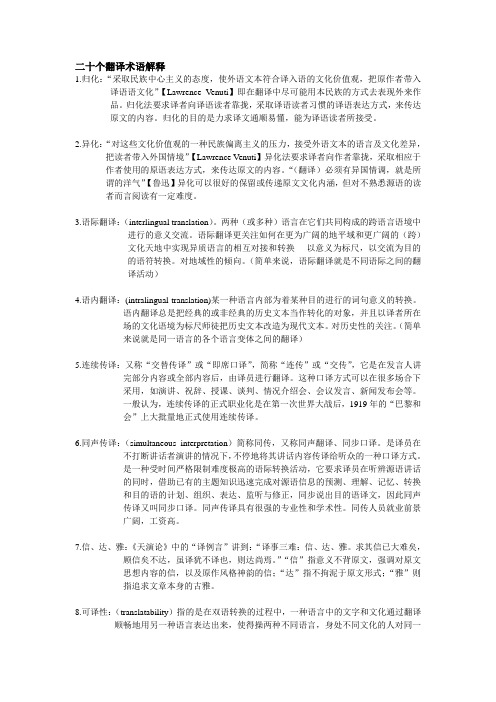
二十个翻译术语解释1.归化:“采取民族中心主义的态度,使外语文本符合译入语的文化价值观,把原作者带入译语语文化”【Lawrence V enuti】即在翻译中尽可能用本民族的方式去表现外来作品。
归化法要求译者向译语读者靠拢,采取译语读者习惯的译语表达方式,来传达原文的内容。
归化的目的是力求译文通顺易懂,能为译语读者所接受。
2.异化:“对这些文化价值观的一种民族偏离主义的压力,接受外语文本的语言及文化差异,把读者带入外国情境”【Lawrence V enuti】异化法要求译者向作者靠拢,采取相应于作者使用的原语表达方式,来传达原文的内容。
“(翻译)必须有异国情调,就是所谓的洋气”【鲁迅】异化可以很好的保留或传递原文文化内涵,但对不熟悉源语的读者而言阅读有一定难度。
3.语际翻译:(interlingual translation)。
两种(或多种)语言在它们共同构成的跨语言语境中进行的意义交流。
语际翻译更关注如何在更为广阔的地平域和更广阔的(跨)文化天地中实现异质语言的相互对接和转换----以意义为标尺,以交流为目的的语符转换。
对地域性的倾向。
(简单来说,语际翻译就是不同语际之间的翻译活动)4.语内翻译:(intralingual translation)某一种语言内部为着某种目的进行的词句意义的转换。
语内翻译总是把经典的或非经典的历史文本当作转化的对象,并且以译者所在场的文化语境为标尺师徒把历史文本改造为现代文本。
对历史性的关注。
(简单来说就是同一语言的各个语言变体之间的翻译)5.连续传译:又称“交替传译”或“即席口译”,简称“连传”或“交传”,它是在发言人讲完部分内容或全部内容后,由译员进行翻译。
这种口译方式可以在很多场合下采用,如演讲、祝辞、授课、谈判、情况介绍会、会议发言、新闻发布会等。
一般认为,连续传译的正式职业化是在第一次世界大战后,1919年的“巴黎和会”上大批量地正式使用连续传译。
6.同声传译:(simultaneous interpretation)简称同传,又称同声翻译、同步口译。
英语翻译术语
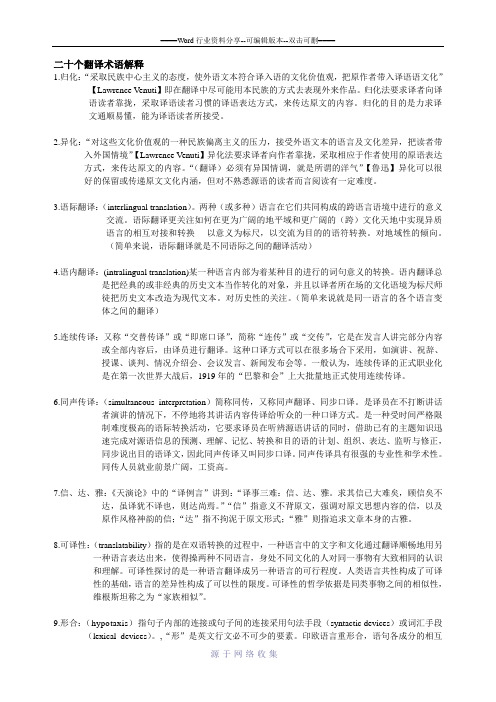
二十个翻译术语解释1.归化:“采取民族中心主义的态度,使外语文本符合译入语的文化价值观,把原作者带入译语语文化”【Lawrence Venuti】即在翻译中尽可能用本民族的方式去表现外来作品。
归化法要求译者向译语读者靠拢,采取译语读者习惯的译语表达方式,来传达原文的内容。
归化的目的是力求译文通顺易懂,能为译语读者所接受。
2.异化:“对这些文化价值观的一种民族偏离主义的压力,接受外语文本的语言及文化差异,把读者带入外国情境”【Lawrence Venuti】异化法要求译者向作者靠拢,采取相应于作者使用的原语表达方式,来传达原文的内容。
“(翻译)必须有异国情调,就是所谓的洋气”【鲁迅】异化可以很好的保留或传递原文文化内涵,但对不熟悉源语的读者而言阅读有一定难度。
3.语际翻译:(interlingual translation)。
两种(或多种)语言在它们共同构成的跨语言语境中进行的意义交流。
语际翻译更关注如何在更为广阔的地平域和更广阔的(跨)文化天地中实现异质语言的相互对接和转换----以意义为标尺,以交流为目的的语符转换。
对地域性的倾向。
(简单来说,语际翻译就是不同语际之间的翻译活动)4.语内翻译:(intralingual translation)某一种语言内部为着某种目的进行的词句意义的转换。
语内翻译总是把经典的或非经典的历史文本当作转化的对象,并且以译者所在场的文化语境为标尺师徒把历史文本改造为现代文本。
对历史性的关注。
(简单来说就是同一语言的各个语言变体之间的翻译)5.连续传译:又称“交替传译”或“即席口译”,简称“连传”或“交传”,它是在发言人讲完部分内容或全部内容后,由译员进行翻译。
这种口译方式可以在很多场合下采用,如演讲、祝辞、授课、谈判、情况介绍会、会议发言、新闻发布会等。
一般认为,连续传译的正式职业化是在第一次世界大战后,1919年的“巴黎和会”上大批量地正式使用连续传译。
6.同声传译:(simultaneous interpretation)简称同传,又称同声翻译、同步口译。
- 1、下载文档前请自行甄别文档内容的完整性,平台不提供额外的编辑、内容补充、找答案等附加服务。
- 2、"仅部分预览"的文档,不可在线预览部分如存在完整性等问题,可反馈申请退款(可完整预览的文档不适用该条件!)。
- 3、如文档侵犯您的权益,请联系客服反馈,我们会尽快为您处理(人工客服工作时间:9:00-18:30)。
The current definition(1)1. Translation consists in reproducing in the receptor language the closest natural equivalence of the source language, first in terms of meaning and secondly in terms of style. ---------Nida2. Catford defines translation as “th e replacement of texual material in one language (SL) by equivalent texual matererial in another language (TL)” (1965:21)3. A good translation is one which has the merit of the original work is so completely transfused into another language as to be as distinctly apprehended and as strongly felt by a native of the country to which that language belongs as it is by those who speak the language of the original work.---------TytlerThe current definition(2)•The replacement of textual material in one language (SL) by equivalent textual material in another language (TL)----------------Prof. Huang Long Translatology•翻译是把一种语言所承载的文化信息转换成另一种另一种语言的文化信息,它包括语内翻译、语际翻译和符际翻译。
(曹明伦)•翻译是把一种语言表达的意义用另一种语言表达出来,以达到沟通思想情感、传播文化知识、促进社会文明,特别是推动译语文化兴旺昌盛的目的。
(孙致礼)In summary--Translation is the information transferring between two languages and the cultural communication between two language families.--Translation is a rendering from one language into another. Translation is an art, a bilingual art, a craft, a skill, an operation and communication.--Translation is a representation or recreation in one language of what is written or said in another language.Classification of Translationa) In terms of languages• 1. Translation from native languages into foreign languages• 2. Translation from foreign languages into native languagesb) In terms of mode• 1. oral interpretation• 2. written translation• 3. machine translationC).SL and TL: Interlingual translation, Intralingual translation, Intersemiotic translationd). In terms of disposal (处理方式)• 1. full-text translation (全文翻译)• 2. abridged /adapted translation•(摘译/辑译)•译写?Tytler’s•Essay on the Principles of Translation, 1790• A translation should give a complete transcript of the ideas of the original work;•The style and manner of writing should be of the same character as that of the original;• A translation should have all the ease of the original composition.Yan Fu’s•Faithfulness, Expressiveness and Elegance•“Faithfulness” means the full and complete conveying of the original content of thought;•“Expressiveness” demands that the version should be clear and flowing without any grammatical mistakes or confused logic andsense;•“Elegance” refers to the use of classical Chinese before the Han Dynasty.Others’ translation principles (1)•Lu Xun’s: Rather be faithful (in thought) than smooth (in language) in opposition to Liang Shi-qiu’s translation principle in 1930s.•Fu Lei’s : TL should be similar to SL both in Form and inSpirit.•Liu Zhongde’s : faithfulness, expressiveness and closeness.faithfulness: to be faithful to the content of the original;expressiveness: to be as expressive and smooth as the original;closeness: to be as close to the original style as possible.(信、达、切)•Liang Shiqiu ‘s and Zhao Jingshen’s : “It’s better to have a smooth version than a faithful one.”中国传统译伦四大支柱:案本---求信---神似---化境•Eugene A. Nida’s : Dynamic equivalence or Functional equivalence or Equivalent-effect theory.•The translator is to produce as nearly possible the same effect on his readers as was produced on the readers of the original.•Peter Newmark’s : Semantic translation and Communicative translation.•Semantic translation: The translator attempts, within the bare syntactic and semantic constraints of the TL, to produce the precise contextual meaning of the author. Semantic translation focusesprimarily upon the semantic content of the source text.•Communicative translation: The translator attempts to produce the same effect on the TL readers as was produced by the originalon the SL readers. Communicative translation focuses essentiallyupon the comprehension and response of receptors.•Faithfulness and smoothness•Faithfulness refers to that content and style of TL should be faithful to the SL.•Smoothness requires that version should be clear and distinct, flowing and easy to read without signs of the mechanicalword-for-word translation, of obscure language, of grammaticalmistakes, confused structure and logic.Transforeignization and domestication lation strategies:•Foreignization:If the translator’s preference is placed on preserving the language and cultural differences of the SourceText, we call this kind of approaches or its translation foreignizingor foreignization.(SL culture-oriented strategy)•Domestication:the method or practice of adapting the translation to the norms and values of the Target Language and culture iscalled domesticating or domestication. (TL culture-orientedstrategy)Two basic translation methods•Literal Translation means word-for-word translation. It takes sentences as its basic units and the whole text into consideration atthe same time in the course of translation. It strives to reproduceboth the ideological content and the style of the entire literary work and retain as much as possible the figures of speech.•Liberal Translation is also called Free Translation. It is a supplementary means to mainly convey the meaning and spirit ofthe original without trying to reproduce its sentence pattern orfigures of speech.•Polysemy: One word has various parts of speech and various meaning. Firth said: “Each word when used in a new context is anew word.”•Commendatory and derogatory words: Commendatory word means a praising word, or a word in good sense. Derogatory wordmeans a word to lessen or impair the power or authority or a wordin bad sense.•Diction: It means proper choice of words in translation on the basis of accurate comprehension of the original.•Repetition: In translation we are required to repeat words over and over again for clearness, for the sake of emphasis and forattractiveness (vividness).•Amplification: It means supplying necessary words in our translation work so as to make the version correct and clear. Words thus supplied must be indispensable either syntactically orsemantically.•Omission: In the process of translation we may make proper omission of some individual words in accordance with thecorresponding laws inherent in the two languages concerned inorder to retain and better express the original meaning.•Conversion: It means that in translation a word in one language belonging to a certain part of speech is not necessarily to be turned into one of the same part of speech in another language.•Inversion: By inversion in translation we mean that the constituent elements of a sentence are arranged in way different from thegeneral rules of word order of the language in question.•Negation: It means in translation some words, phrases or sentences with negative expression in SL may be transformed into affirmative expression in TL. Vice versa, some affirmative expression in SLmay be transformed into negative expression in TL, to make theversion clearer and more explicit.•Division: It means the necessary splitting of a long sentence into shorter ones.Change of the voice•the active and the passive•E-C : the active voice•C-E : the passive voice esp. in EST (English for Science and Technology)。
